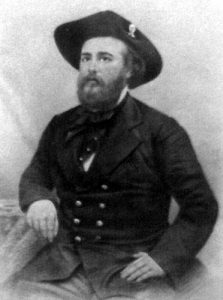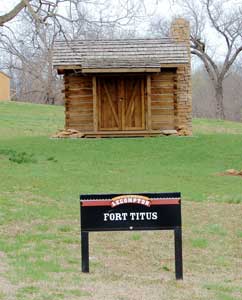Colonel Henry Theodore Titus was a soldier and pro-slavery advocate in Kansas Territory.
On February 13, 1823, Titus was born in Trenton, New Jersey, but grew up in Kentucky. He was a member of the Lopez Expedition against Cuba with the rank of Adjutant. He arrived in Kansas about April 1, 1856, in company with Colonel Jefferson Buford and about 1,000 men recruited in the South. His earliest endeavors in this section were put forth in the interests of the pro-slavery cause. He was present at the Sacking of Lawrence on May 21, 1856, and on about August 1st, he forcibly took possession of a claim about two miles east of Lecompton, belonging to a Free-State man named Smith, one of the earliest settlers in the territory. Smith’s cabin was torn down during his absence, and Titus erected a blockhouse for himself that he referred to as “Fort Titus.”
On August 12, 1856, David S. Hoyt, a Free State advocate, was killed by pro-slavery men near Fort Saunders, a pro-slavery stronghold about 12 miles east of Lawrence. Afterward, the free-state men retaliated by surrounding and making an assault upon Fort Titus besieged the garrison, and one free-state man was killed. Finding that rifles made no apparent impression on the log fort, the free-state men then brought out a cannon and trained it on the blockhouse. Six shots were fired when a wounded Colonel Titus signaled that he wished to surrender. One or two of his companions were killed.
The prisoners were all taken to Lawrence and, sometime later, were released. His sword surrendered at the time of the battle and is now preserved in the Kansas State Historical Society museum at Topeka.
On October 11, 1856, Governor John W. Geary appointed him special aide-de-camp, his commission post-dated to September 15th. Sometime after the battle of Fort Titus, he issued a call for his regiment of militia, signing himself “Colonel of the Second Regiment of the First Brigade of the Southern Division of the Kansas Militia.” His military career in Kansas began and ended in 1856.
Early in 1857, he became associated with General William Walker in his Nicaraguan Expedition. In February of that year, he arrived at San Juan del Norte at the head of about 180 men, many of whom had been associated with him in Kansas. His military capabilities displayed in this expedition proved his incapacity as a commander, described by those who knew him, as a swaggering braggart. It was commonly rumored that he lost his life in the Nicaraguan Expedition, but this was a mistake. He actually died in Florida on August 8, 1881.
Compiled and edited by Kathy Alexander/Legends of Kansas, updated April 2022.
Also See:
Bleeding Kansas & the Missouri Border War
Territorial Kansas & the Struggle for Statehood


